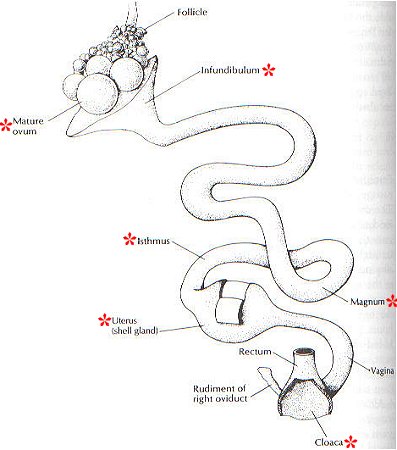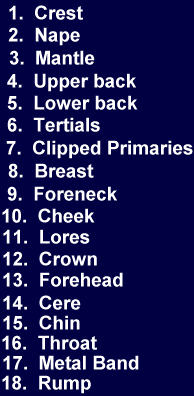

The avian skeleton is very unique and in most species is specially adapted for flight. It is a
very lightweight and delicate yet very strong. Most of the long bones are hollow but reinforced
through a honeycombed substructure. The main thing you need to know about is the sternum.
Flying species have a pronounced keel, the place on the sternum that the flight muscles
attach to. Birds that are clipped to severely can crash land and easily injure their keel. See
the Respiratory System below for more information on the sternum and it's function.
The avian respiratory system differs from mammals in many ways. Bird respiration is much more
efficient. Birds do not have a diaphram.
In mammals this muscle moves up and down to increase and decrease the chest cavity.
Birds push the sternum in and out to the same effect. Owners therefore must be careful when
holding their birds about the waist. If held too tightly the sternum will not be able to expand
and the bird will suffocate. Breathing rate varies depending on size of birds.
A hummingbird breathes 143 times per minute while a turkey breathes
7 times per minute. This rate increases during flight. The flow of air enters through the
nostrils, down the trachea and into the lungs and air sacs. The trachea, or windpipe, is
what breeders have to be careful of while handfeeding. Syringes should be aimed from the
bird's left to right (over the trachea and into the esophogus) to avoid aspirating the
chick. Bird lungs are very compact and take up much less space than mammal lungs.
With the help of thin-walled air sacs
which extend through the body cavity and even into the bones, birds can keep a continuous flow
of air through the lungs.

 Skeletal System
Skeletal System Respiratory System
Respiratory System


 Digestive System
Digestive SystemBirds has special digestive tracts because for the most part they do not chew their food. All breakdown must take place within the system itself. First the food travels down through the esophagus and into the crop. The crop is actually just an expanded section of the esophagus. It is used as a holding tank for food before it can enter the proventriculus. The proventriculus produces acid and adds enzymes which aid in breaking down the food, which is next passed to the gizzard. The gizzard helps grind food tougher food like seed. According to Ornithology by Gill, a turkey gizzard can "pulverize English walnuts, steel needles, and surgical lancets." The gizzard is highly keratinized to make the surface rough (keritan is what makes up fingernails and hair). Food then takes its time passing through the intestinal tract, where nutrients are absorbed. Waste is then expelled through the cloaca, or vent.
 Reproductive System
Reproductive System
The reproductive organs shrink whenever birds are not in season. This drastically decreases their weight, making flight easier. Males have two testes and females have one ovary. Eggs are produced thus: The ovum is fertilized and passes through a long tube called the oviduct. Each section of the oviduct adds a different part to the egg, just like an assembly line. In the infundibulum the egg stays 20 minutes before passing along to the magnum, where the albumen (egg white) is added. Now the egg goes to the isthmus, where inner and outer membranes are formed around the albumen. This takes about an hour. In the uterus the shell and all pigments are added. This process takes the longest, about 20 hours. The egg then passes through the vagina and out the cloaca.
 Body Parts
Body Parts
Ever wondered what names like green-cheeked conure, golden-mantled rosella, red-lored amazon and red-rumped parakeet are referring to? Check out the body diagrams.
 |


|

All articles and images contained on this site are © 1998, 1999 by Feisty Feathers unless otherwise noted and may not be reprinted or used in any way without the author's permission. **The skeleton and internal organ prints came from Parrots of the World by Forshaw.**